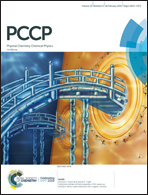Intrinsic effects of strain on low-index surfaces of platinum: roles of the five 5d orbitals†
Abstract
Surface strain has been widely applied in catalyst design. It has been reported that tensile strain can weaken the adsorption of species on certain metal surfaces similar to the effects of compressive strain. This result contradicts the widely accepted rule predicated on the d-band center. Here, by using DFT calculations, we confirmed the abnormal adsorption behaviour of certain species on strained Pt low-index surfaces and found that the behaviour is dependent on the surfaces and species. Tensile strain on the close-packed Pt(111) and Pt(100) surfaces enhances species adsorption, while tensile strain on the open Pt(110) surface weakens species adsorption. This result is attributed to the asynchronous change in the five 5d orbitals due to the inconsistency between interlayer contraction and biaxial stretching. The dramatic contraction of interlayer spacing on the tensile strained Pt(110) surface sharply downshifts the dz2 center, then weakens species adsorption. Thus, due to the different roles of the five d orbitals in binding species, the inconsistent change in the five d orbitals is the intrinsic mechanism of the effects of strain on metal catalysts. Selectively tuning the five d orbitals might provide a new strategy to modify the adsorption behaviour of species on Pt-based catalysts and may result in extraordinarily high catalytic activities.



 Please wait while we load your content...
Please wait while we load your content...